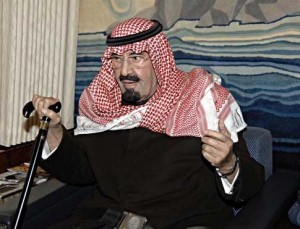
The unfolding events in Libya mark the first uprising in a major oil producing country. Meanwhile,unrest in Yemen and Bahrain,which Saudi Arabia is intensely involved,has erupted in shouts of freedom. In an era in which social internet media act as liberating messaging systems the question arises:how long can the Kingdom of Saudi Arabia stand on its feet?
Saudis deal with the crisis pushing cash to the people. Saudi Arabia has already announced fiscal spending packages worth USD 120 billion in attempt to stop the wave of uprisings spreading in one of the world’s major oil exporters;warnings do exist that crude oil can shoot up to $200 a barrel. Pricing in Libya supply disruptions are already troubling markets,but what if the domino hits Saudi Arabia,which holds 20% of the world’s oil,wonders David Rosenberg,chief economist and strategist for Gluskin in an interview with CNBC. “Do the math:we’d be talking about $200 a barrel”.
In a report published by UBS called “A middle east stress test”,it is argued that Saudi Arabia shares some characteristics that have been causes for unrest in Tunisia and Egypt,such as high unemployment among its youth and public-sector corruption. Also,the Saudi Kingdom is similar to Bahrain,where the restless Shiite minority races in rebellion against the Sunni-led monarchy.
Charles Robertson,an analyst at Renaissance Capital,said investors are very concerned about what might happen in Saudi Arabia’s oil rich east province,where the Shiite minority is concentrated. Although,unlike in Bahrain,Sunni are a big majority.
On the other hand,protests have halted so far and the widespread legitimacy for the ruling al Saud family,is not yet a reason to worry about political instability,analysts argue. The USD 120 billion package,if spent over several years,could theoretically be financed out of government revenues. This is because Saudi government revenues stand to benefit from combination of higher oil prices plus increased oil output to compensate for the loss of Libya’s oil production.
Unlike many other regional governments currently facing unrest,the Kingdom is sitting on more than USD 457 billion in foreign reserves amassed during the reign of King Abdullah. Thus,under a situation that both the price of oil as well as Saudi oil output were to decline in 2011,the Saudis have more than sufficient foreign assets to support their increased spending commitments. If oil prices were to decline for a sustained period,then fiscal austerity would also come to the Kingdom,but that is not the situation today.
Just as important,however,is the widespread view that King Abdullah is a vey popular leader of a monarchy seen as legitimate by the vast majority of Saudi citizens. Still however,analysts worry about what will happen to the Kingdom when the time for succession comes. The Kingdom recently set up the “Allegiance Commission”,which will choose the next leader from the sons and grandsons of King Abdul-Aziz,who united the Kingdom in 1932. This is thought of ensuring that transitions are smooth and popularly supported.
The economic and political situation in Saudi Arabia is in a much better shape than those in Tunisia,Egypt,or Libya or its regional neighbours. However,risk factors remain unchanged.
Επιμέλεια:J.J.